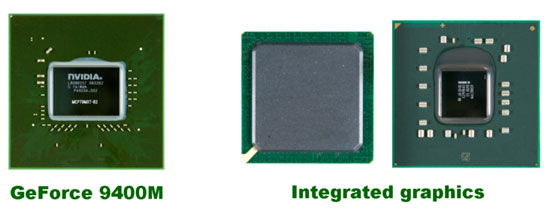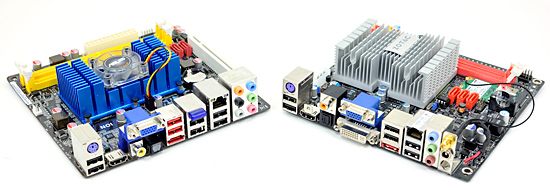NVIDIA's Bumpy Ride: A Q4 2009 Update
by Anand Lal Shimpi on October 14, 2009 12:00 AM EST- Posted in
- GPUs
Chipsets: One Day You're In and the Next, You're Out
Presently, NVIDIA’s chipset business is far from dead. They are in nearly every single Apple computer on the market, not to mention countless other OEMs. I’m not sure how much money NVIDIA is making from these chipsets, but they are selling.

NVIDIA won Apple's chipset business, Intel was not happy
Long term I don’t see much of a future for NVIDIA’s chipset business. NVIDIA said that they have no interest in pursuing an LGA-1156 chipset given Intel’s legal threats. Even if NVIDIA had a license to produce DMI chipsets, I’m not sure it makes sense.

NVIDIA's Advantage: A single chip GeForce 9400M instead of a dated Intel solution
Once the ‘dales hit, every single mainstream CPU from Intel is going to come with graphics on-package. Go out one more generation and Sandy Bridge brings the graphics on-die. AMD is doing the same thing starting in 2012.
It’s taken longer than expected, but there’s honestly no need for a third party chipset maker anymore. Most of the performance differentiation in chipsets has been moved onto the CPU die anyway, all that’s left are SATA, USB, and a bunch of validation that no one likes doing. NVIDIA is much better off building a discrete GeForce 9400M GPU at low cost and selling that. There’s much less headache involved with selling discrete GPUs than selling chipsets, plus graphics is NVIDIA’s only value add when it comes to chipsets - everyone knows how to integrate a USB controller by now. I’d say the same about SATA but AMD still has some AHCI silliness that it needs to sort out.
NVIDIA committed to supporting existing products in the channel and continues to poke fun at AMD with lines like this:
“On AMD platforms, we continue to sell a higher quantity of chipsets than AMD itself. MCP61-based platforms continue to be extremely well positioned in the entry CPU segments where AMD CPUs are most competitive vs. Intel”
As successful as NVIDIA’s AMD chipsets are today, AMD is telling us that nearly all OEM designs going forward use AMD chipsets. Again, NVIDIA’s chipset business is quite healthy today, but I don’t see much of a future in it - not that it’s a bad thing.
The only reason NVIDIA’s chipset business has lasted this long is because AMD and Intel couldn’t get their houses in order quickly enough. AMD is finally there and Intel is getting there, although it remains to be seen how well the next-generation of Atom platforms will work in practice.

A pair of Ion motherboards we reviewed
The main reason Ion got traction in the press was because it could play Blu-ray content. If Intel had done the right thing from the start and paired Atom with a decent chipset, NVIDIA would never have had the niche for Ion to fit into.










106 Comments
View All Comments
Zool - Thursday, October 15, 2009 - link
And what is such a novelty on Nvidia that other dont hawe ? Oh wait maybe the PR team or the shiny flashy nvidia page that lets you believe that even the most useless product is the customers neverending dream.I need to admit that AMD is way behind in those areas.
I wouldnt say its novelty but it seems its working for the shareholders.
jasperjones - Wednesday, October 14, 2009 - link
Anand, while I generally agree with your comment, I believe there is one area where Nvidia has a competitive advantage: drivers and software.Two examples:
- the GPGPU market. On the business side, double-precision (DP) arithmetic is of tremendous importance to scientists. GT200 is vastly inferior in DP arithmetic to R700, yet people bought Nvidia due to better software (ATI is also better in DP performance if you compare its enterprise GPUs to similarly-priced Nvidia GPUs). On the consumer side, look at the sheer number of apps that use CUDA vs the tiny number of apps that use Stream. If I look at other things (OpenCL or C/C++/Fortran support), I also see Nvidia ahead of AMD/ATI.
- Linux drivers. AMD has stepped things up but Nvidia drivers are still vastly superior to ATI drivers.
I know they're trading blows in some other areas closely related to software (Nvidia has Physx, AMD DX11) but my own experience still is Nvidia has the better software.
medi01 - Friday, October 16, 2009 - link
Pardon me, but isn't like 95+% of the gaming market - Windows, not Linux?AtwaterFS - Wednesday, October 14, 2009 - link
Where is Silicon Doc? Is he busy shoving a remote up his a$$ as Nvidia takes it up theirs? MUAHAHAHAHA!Seriously tho, I need Nvidia to drop price on 58xx cards so I can buy one for TES 5 / Fallout 4 - WTF!
tamalero - Sunday, October 18, 2009 - link
he was banned, you forgot?Transisto - Wednesday, October 14, 2009 - link
I never play games but spend a lot of money (to me) and time info a folding farm.The winter is setting and I plan on heating the whole house from these. 9600 9800 and 260. So timing is now !
To me this is a bad time to invest into folding GPUs because the decisions are taking too much precious brainwidth.
My worries are:
Will there still be a demand for low end 9600 and gts250 even g200 card once the G300 come out ?
And more importantly would the performance of these antique g92 and g200 still be efficient at research computing (price wise).
I was actually purchasing more gtx 260s because these could still sell out after I upgrade to better. But these day I am more into buying used g92s on the cheap.
Thank You.
The0ne - Wednesday, October 14, 2009 - link
This doesn't come as a shock to the "few" of us that had believe NVidia was in trouble, won't have competition and will most likely leave the high end business video market. I've even posted a link on a Dailytech article, although from a ironic website name.What I'm concern about is why there aren't reports are the issues around NVidia's business/management? They have been undergoing restructuring for at least a year now and workers have been laid off here and there. Does Anandtech have any info on this matter? I haven't check lately but the CA based has been struggling.
Personally, I think some "body" has gone Financial on the business and NVidia is suffering. Planning and strategies are either nonexistent, poor, or poorly communicated/executed. I think they're going to fail and go the way of Matrox. It's too bad since they were doing well. I've been around too many companies like this to not know that upper management just got greedy and lazy. Again, that's just personal opinion from what I've read and know.
Anyone has any direct info regarding my concerns?
iwodo - Wednesday, October 14, 2009 - link
Where did you heard they have laid off? As far as i am concern they are actually hiring MORE engineers to work on their products.frozentundra123456 - Wednesday, October 14, 2009 - link
I have to say that I am somewhat disappointed with AMDs new lineup, even though I would prefer AMD to do well. They sure need it.If nVidia could switch to DDR5 and keep a larger bus, it seems like they could really outperform AMD. Even the current generation of cards from nVidia is relatively competitive with AMDs new cards except of course for Dx11. The "problem" is that nVidia seems to be trying to do too much with the GPU instead of just making good graphics performance.
Anyway, lets hope that the new generation from nVidia at least is competitive enough to push down prices on AMDs new lineup, which seems overpriced for the performance, especially the 5770 and to a lesser extent the 5750.
MonkeyPaw - Wednesday, October 14, 2009 - link
The problem is, it's all about making a profit. The GT200 was in theory a great product, but AMD essentially matched it with RV770, vastly eroding nVidia's profits on their entire top line. GT300 might be fantastic, but let's be realistic. The economy kinda sucks, and people are worried about becoming unemployed (if they aren't already). Being the best at all costs only works in prosperous times, but being good enough at the best price means much more in times like these. And considering that it takes 3 monitors to stress a 5870 on today's titles, how much better does the GT300 need to be?